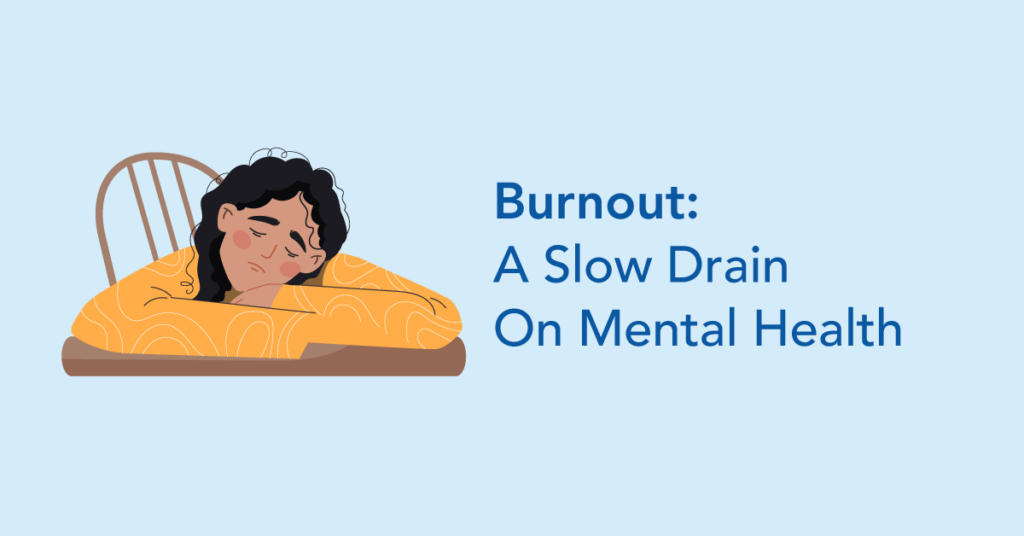Burnout is chronic emotional exhaustion:
Caused by prolonged stress, especially at work
Symptoms include fatigue, detachment, low motivation
Recovery requires rest and boundary-setting
Burnout is more than just feeling tired or overwhelmed. It’s a prolonged state of emotional, physical and mental exhaustion caused by chronic stress, especially in work or caregiving environments. While anyone can feel drained at times, burnout is a deeper and more persistent condition that can impact nearly every area of your life.
In fact, the World Health Organization officially recognizes burnout as an occupational phenomenon, emphasizing how widespread and serious this issue has become. Understanding the signs, causes and strategies for burnout recovery is key to protecting your long-term mental health.
What Is Burnout?
Burnout is considered not a medical condition but a state of mental exhaustion that occurs when long-term stress is left unmanaged. It can be triggered by work pressure, personal responsibilities, emotional strain or a combination of these. Over time, burnout affects mood, energy, productivity and relationships.
Some common descriptions of burnout include:
- Feeling emotionally drained
- Becoming increasingly detached or cynical
- Losing motivation to complete tasks
- Struggling with sleep, focus or appetite
Burnout can develop gradually, and without intervention, it can contribute to serious mental health issues such as depression, anxiety and substance use.
Common Signs and Symptoms of Burnout
Burnout manifests differently for each person, but there are several telltale signs to watch for:
- Chronic fatigue. Feeling exhausted even after a full night’s sleep
- Sleep disturbances. Trouble falling or staying asleep
- Loss of motivation. Difficulty starting or completing tasks
- Irritability. Low tolerance for stress, frustration or other people
- Forgetfulness and poor concentration. Memory lapses and difficulty staying focused
- Physical symptoms. Headaches, muscle tension, gastrointestinal issues
- Withdrawing socially. Isolating from friends, family or coworkers
- Pessimism. A persistent negative outlook on work, self or life in general
These symptoms may develop slowly or appear suddenly. Recognizing them early can help you take action before burnout becomes unmanageable.
The 5 Stages of Burnout
Burnout doesn’t happen overnight. It tends to follow a progression that can be broken down into five general stages:
- The Honeymoon Phase. You’re enthusiastic about a new job, task or role and may take on more than you can handle.
- Onset of Stress. Pressure builds as responsibilities increase. You may start skipping breaks, sacrificing sleep or neglecting your needs.
- Chronic Stress. Symptoms of stress become constant. You may feel emotionally drained and begin withdrawing from others.
- Burnout. Fatigue, cynicism and a lack of accomplishment take hold. Health and work performance may decline.
- Habitual Burnout. Burnout becomes a long-term condition, increasing the risk of depression, anxiety or other mental health concerns.
Causes and Triggers of Burnout
Understanding what’s fueling your burnout is crucial for creating change. Common causes include:
- Excessive workloads or unrealistic deadlines
- Lack of control over job responsibilities
- Conflicting values or workplace culture issues
- Lack of recognition or support
- Caregiving responsibilities without adequate breaks
- Chronic emotional stress or trauma
You might also experience burnout from being in a “helper” role, such as nursing, teaching, parenting or social work, where emotional labor is constant and underappreciated.
The Mental Health Effects of Burnout
If left untreated, burnout can evolve into deeper mental health challenges. Many people with burnout develop symptoms consistent with:
- Major depressive disorder
- Generalized anxiety disorder
- Panic attacks
- Substance use
- Chronic insomnia
The emotional exhaustion that comes with burnout may make you feel disconnected from your identity, relationships and goals. You might question your purpose, feel ineffective or become emotionally numb.
Recovery and Burnout Prevention Strategies
Burnout recovery requires a shift in mindset, lifestyle and support. Here are several evidence-based approaches that can help:
Rebalance Your Workload
- Set clear limits on working hours.
- Delegate tasks when possible.
- Prioritize essential tasks and cut out unnecessary obligations.
Reclaim Work-Life Boundaries
- Avoid checking work emails after hours.
- Use all available paid time off and breaks.
- Establish a “wind-down” routine to mentally leave work behind.
Build Daily Recovery Habits
- Get consistent sleep.
- Eat nourishing meals.
- Move your body regularly (even walking counts).
- Spend time in nature or in quiet spaces.
Practice Stress Management
- Use mindfulness or meditation to regulate your stress response.
- Try journaling, breathing exercises or guided imagery.
- Engage in hobbies or creative activities that bring joy.
Say No and Ask for Help
- Let go of perfectionism and guilt around rest.
- Practice saying “no” to protect your energy.
- Reach out to friends, family or coworkers when feeling overwhelmed.
When to Seek Professional Help
If your burnout symptoms persist despite self-care efforts or you feel hopeless or trapped, it’s time to talk to a mental health professional. Therapy can help you uncover the root causes of your burnout and develop healthy coping mechanisms. Cognitive behavioral therapy, acceptance and commitment therapy and stress-reduction strategies are particularly effective.
In some cases, a short leave from work or temporary medication support may be recommended to aid your recovery.
Frequently Asked Questions
Burnout isn’t classified as a mental illness, but it can significantly impact mental health and may contribute to the development of conditions such as depression or anxiety.
Recovery can vary. With support and lifestyle changes, some people feel better within a few weeks. For others, especially those in stage 4 or 5 burnout, it may take months.
Yes, by recognizing early warning signs and building strong self-care habits, many people can avoid full burnout. Setting boundaries and taking breaks is key.
Some people reduce their hours or modify their workload. Others may take medical leave. Every situation is different, so work with your provider to determine the best approach.
A Path Back to Balance
Burnout is real, and it’s more than just feeling overworked. It affects your mind, body and sense of self. But with the right tools, support and a commitment to self-care, it’s possible to recover and rebuild a healthier, more sustainable life.
If burnout is impacting your mental health, reach out to the Mental Health Hotline anytime, day or night. We can connect you with licensed counselors and therapists who can guide you toward healing.
Editorial Team
-
 Written By: Mental Health Hotline
Written By: Mental Health HotlineMental Health Hotline provides free, confidential support for individuals navigating mental health challenges and treatment options. Our content is created by a team of advocates and writers dedicated to offering clear, compassionate, and stigma-free information to help you take the next step toward healing.


